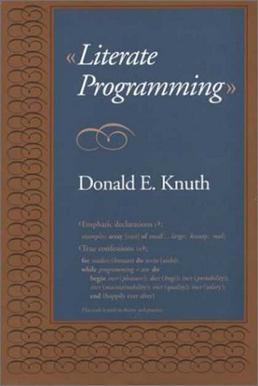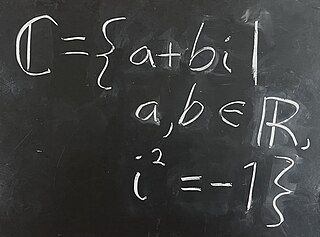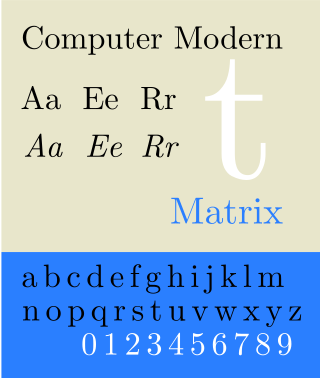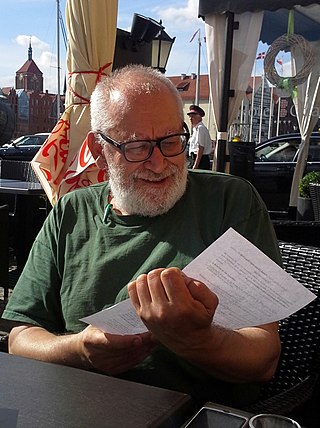
Donald Ervin Knuth is an American computer scientist and mathematician. He is a professor emeritus at Stanford University. He is the 1974 recipient of the ACM Turing Award, informally considered the Nobel Prize of computer science. Knuth has been called the "father of the analysis of algorithms".

Literate programming is a programming paradigm introduced in 1984 by Donald Knuth in which a computer program is given as an explanation of how it works in a natural language, such as English, interspersed (embedded) with snippets of macros and traditional source code, from which compilable source code can be generated. The approach is used in scientific computing and in data science routinely for reproducible research and open access purposes. Literate programming tools are used by millions of programmers today.

LaTeX is a software system for typesetting documents. LaTeX markup describes the content and layout of the document, as opposed to the formatted text found in WYSIWYG word processors like Microsoft Word, LibreOffice Writer and Apple Pages. The writer uses markup tagging conventions to define the general structure of a document, to stylise text throughout a document, and to add citations and cross-references. A TeX distribution such as TeX Live or MiKTeX is used to produce an output file suitable for printing or digital distribution.

A markuplanguage is a text-encoding system which specifies the structure and formatting of a document and potentially the relationship between its parts. Markup can control the display of a document or enrich its content to facilitate automated processing.

PostScript is a page description language and dynamically typed, stack-based programming language. It is most commonly used in the electronic publishing and desktop publishing realm, but as a Turing complete programming language, it can be used for many other purposes as well. PostScript was created at Adobe Systems by John Warnock, Charles Geschke, Doug Brotz, Ed Taft and Bill Paxton from 1982 to 1984. The most recent version, PostScript 3, was released in 1997.
TeX, stylized within the system as TeX, is a typesetting program which was designed and written by computer scientist and Stanford University professor Donald Knuth and first released in 1978. The term now refers to the system of extensions - which includes software programs called TeX engines, sets of TeX macros, and packages which provide extra typesetting functionality - built around the original TeX language. TeX is a popular means of typesetting complex mathematical formulae; it has been noted as one of the most sophisticated digital typographical systems.

The Art of Computer Programming (TAOCP) is a comprehensive monograph written by the computer scientist Donald Knuth presenting programming algorithms and their analysis. Volumes 1–5 are intended to represent the central core of computer programming for sequential machines.

Blackboard bold is a style of writing bold symbols on a blackboard by doubling certain strokes, commonly used in mathematical lectures, and the derived style of typeface used in printed mathematical texts. The style is most commonly used to represent the number sets , (integers), , , and .
Metafont is a description language used to define raster fonts. It is also the name of the interpreter that executes Metafont code, generating the bitmap fonts that can be embedded into e.g. PostScript. Metafont was devised by Donald Knuth as a companion to his TeX typesetting system.
MetaPost refers to both a programming language and the interpreter of the MetaPost programming language. Both are derived from Donald Knuth's Metafont language and interpreter. MetaPost produces vector graphic diagrams from a geometric/algebraic description. The language shares Metafont's declarative syntax for manipulating lines, curves, points and geometric transformations. However,

Computer Modern is the original family of typefaces used by the typesetting program TeX. It was created by Donald Knuth with his Metafont program, and was most recently updated in 1992. Computer Modern, or variants of it, remains very widely used in scientific publishing, especially in disciplines that make frequent use of mathematical notation.

AMS Euler is an upright cursive typeface, commissioned by the American Mathematical Society (AMS) and designed and created by Hermann Zapf with the assistance of Donald Knuth and his Stanford graduate students. It tries to emulate a mathematician's style of handwriting mathematical entities on a blackboard, which is upright rather than italic. It blends very well with other typefaces made by Hermann Zapf, such as Palatino, Aldus and Melior, but very badly with the default TeX font Computer Modern. All the alphabets were implemented with the computer-assisted design system Metafont developed by Knuth. Zapf designed and drew the Euler alphabets in 1980–81 and provided critique and advice of digital proofs in 1983 and later. The typeface family is copyright by American Mathematical Society, 1983. Euler Metafont development was done by Stanford computer science and/or digital typography students; first Scott Kim, then Carol Twombly and Daniel Mills, and finally David Siegel, all assisted by John Hobby. Siegel finished the Metafont Euler digitization project as his M.S. thesis in 1985.
TeX font metric (TFM) is a font file format used by the TeX typesetting system. It is a font metric format, not an outline font format like TrueType, because it provides only the information necessary to typeset the font such as each character's width, height and depth. The actual glyphs are stored elsewhere. This is not unique to TeX; Adobe's AFM files and Windows' PFM files use the same technique.

Concrete Mathematics: A Foundation for Computer Science, by Ronald Graham, Donald Knuth, and Oren Patashnik, first published in 1989, is a textbook that is widely used in computer-science departments as a substantive but light-hearted treatment of the analysis of algorithms.
In typesetting, a strut is an invisible character or element, used to ensure that a text has a minimum height and depth, even if no other elements are included.

The dangerous bend or caution symbol ☡ was created by the Nicolas Bourbaki group of mathematicians and appears in the margins of mathematics books written by the group. It resembles a road sign that indicates a "dangerous bend" in the road ahead, and is used to mark passages tricky on a first reading or with an especially difficult argument.
A mathematical markup language is a computer notation for representing mathematical formulae, based on mathematical notation. Specialized markup languages are necessary because computers normally deal with linear text and more limited character sets. A formally standardized syntax also allows a computer to interpret otherwise ambiguous content, for rendering or even evaluating. For computer-interpretable syntaxes, the most popular are TeX/LaTeX, MathML, OpenMath and OMDoc.

OCR-A is a font issued in 1966 and first implemented in 1968. A special font was needed in the early days of computer optical character recognition, when there was a need for a font that could be recognized not only by the computers of that day, but also by humans. OCR-A uses simple, thick strokes to form recognizable characters. The font is monospaced (fixed-width), with the printer required to place glyphs 0.254 cm apart, and the reader required to accept any spacing between 0.2286 cm and 0.4572 cm.

The history of sentence spacing is the evolution of sentence spacing conventions from the introduction of movable type in Europe by Johannes Gutenberg to the present day.

Bogusław L. Jackowski, also known as "Jacko", is a Polish computer scientist, typographer, publisher, and amateur musician. He is best known for his work on the TeX typesetting system, the Latin Modern font family, and the TeX Gyre project.














